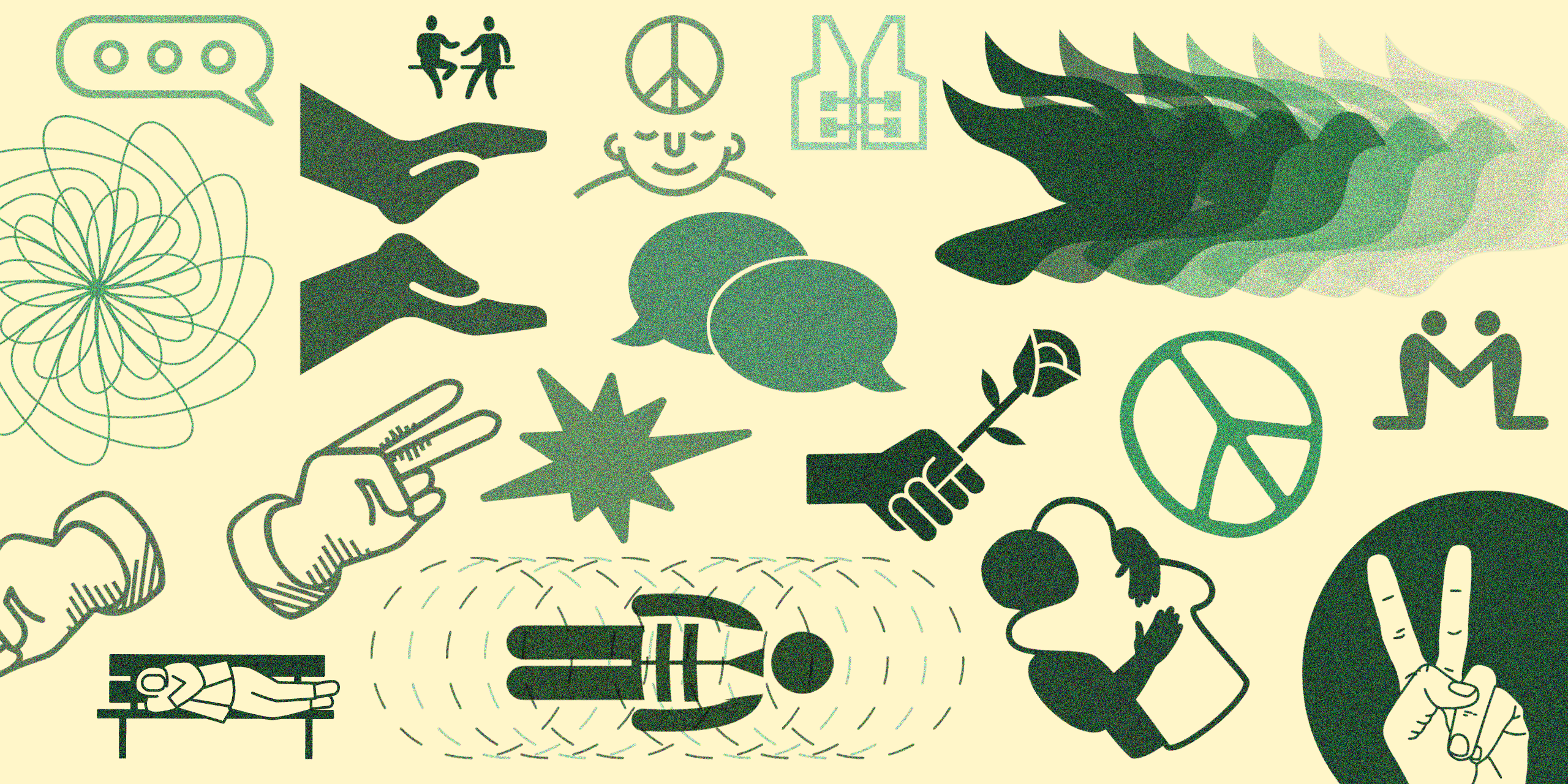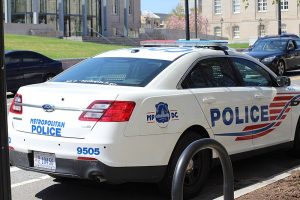Every weekend, Eli McCarthy puts on his bright, high-visibility yellow vest and goes on shift for the D.C. Peace Team (DCPT). Every weekend, McCarthy reimagines public safety. And he’s been doing it for almost a decade.
When activists promote alternatives to the police, they’re often talking about devoting more resources to organizations like DCPT. Founded in 2010, the volunteer-based group specializes in nonviolent conflict resolution and restorative justice.
DCPT street teams offer a new model: security without armed force, but rather through de-escalation and community trust. “Our focus today is really on cultivating the habits and skills of nonviolence in our daily life so our communities can better resist injustice and build a more sustainable, just peace,” McCarthy said.
McCarthy is a board member who works with DCPT’s most visible program: its unarmed civilian protection units. Donning their yellow vest uniforms, the units are deployed in response to demonstrations, ongoing neighborhood conflicts, or to protect individuals experiencing homelessness.
Civilian protection units survey their assigned areas like a patrol route, but rather than the District’s armed Metropolitan Police (MPD), they are composed of unarmed D.C. residents trained in conflict transformation. Unit members attempt to mitigate conflicts without involving police, and often by engaging more than police would, chatting with people and offering resources.
On weekends, McCarthy and his team can be found promoting nonviolent responses at the Columbia Heights Plaza, responding to conflicts between those living around the plaza and those experiencing homelessness who live in the plaza itself. The team has also begun sending units to the Sunday morning Dupont Circle Farmers Market, and is often present at marches and rallies that are expected to be contentious, such as this year’s Black Lives Matter rally.
“You’re not there to police the crowd, you’re there to intervene if you see things escalate,” Sal Corbin, another DCPT board member, said. “[The police] bring escalation, not de-escalation.”
On Oct. 23, McCarthy, who is white, arrived at the plaza around 5 p.m. to about a dozen people, predominantly Latino men, experiencing homelessness. The plaza is surrounded by buildings with security guards, who often physically remove unhoused city residents from their stairs and benches. That day, two MPD officers were standing in one corner of the plaza, and some of the men experiencing homelessness had been drinking. Any one of these factors could lead to conflict: a security guard violently handling a sleeping resident, a drunken fight, overeager policing.
Corbin, who helped set up the first plaza as a regular deployment, said the team chose that area because its designation as a cultural hub also comes with a fairly constant police presence. The police in turn can harass people experiencing homelessness, who congregate in the plaza on nights and weekends. “When everybody comes together there is celebration, there is festival, but there is also clashing,” Corbin said.
McCarthy spent most of the night walking between groups of residents in the plaza, many of whom he personally knows. A few new people were there, and he handed them pamphlets about resources in the area. One man approached, asking for housing. Another was waiting for his favorite DCPT volunteer, Elena, to come by tomorrow. McCarthy, who does not speak Spanish, was clearly on the outside of this community, but he wasn’t
unwelcome. The residents might not have been sure exactly what he was there for, but they didn’t seem to mind that he was present.
This is a pretty standard response to DCPT’s presence, according to Corbin. “Community members are usually welcoming, especially if your presence is consistent,” he said. Deployments at both the plaza and the farmers market are weekly, and the same volunteers often return to the same spots.
DCPT volunteers and board members have been striving to build this sense of community trust for over a decade. The team launched in 2010, when Cortez McDaniel met McCarthy. McDaniel, who was previously incarcerated, wanted to help foment community connections that were so important to his return. After the two attended unarmed protection training, they began to collaborate with local groups to develop an unarmed civilian peacekeeping force, drawn from the communities they would work in.
By the next year, the team had trained 25 community participants, and was helping youth in at-risk neighborhoods get to school through a program called Safe Passage. Over the next few years, DCPT hosted a youth violence prevention conference and developed data collection programs to monitor police aggression during interactions with youth experiencing homelessness in Gallery Place. Since 2012, the team has focused efforts in neighborhoods with historic heavy police presence and high populations of people experiencing homelessness.
The core team meets once a month, in addition to training, committees, and street team deployments. DCPT is registered as a non-profit 501(c)(3) and is funded mainly through donations, including suggested donation rates for training.
Today, DCPT is led by a six-member board and holds training meetings more than once a month. They have one staff administrator, 15 trainers, 30 core team members, and occasional interns, in addition to one-off volunteers and community partners. According to McCarthy, the team is demographically about half Black and Latino at all levels of leadership, and a majority are female.
“A lot of people are kind of looking for some connection, or support, or ways to be constructive,” McCarthy said, noting the group has grown during the pandemic. “We’ve got a bunch of folks who say well, I want to volunteer, can you train me?”
The answer to that question lies in DCPT’s other major initiative: restorative justice events. Both individuals and organizations can benefit from trainings and discussions that focus on nonviolent communication, bystander intervention, and racial justice, among others.
“Restorative circles,” DCPT’s restorative justice roundtables, are at the forefront of this initiative. Facilitators find the circles to be a reliable way to lead community conversations and reach group understandings about conflicts and struggles, as well as ways to collectively heal.
Through a series of rounds, each person in the circle answers the same set of questions set for the event, listens to others, and at the end shares a few key takeaways. The goal is to create a structured listening space that gives everyone a chance to speak and respond to issues the group faces day-to-day.
“These circle processes kinda facilitate folks being able to identify the harm and coming up with places to heal,” McCarthy said.
In addition to bringing peace circles to the city, McCarthy has also introduced the practice at his day job—a Justice and Peace Studies professor at Georgetown University. He worked with student DCPT members to host a campus peace circle during homecoming.
As the pounding rhythm of “Levitating” echoed across campus parties, four students and an administrator came together to talk about the challenges of returning to campus and the Georgetown they wanted to create. Georgetown’s circle featured questions about the challenges of returning to campus (exhaustion, social pressure, enforcing COVID-19 protocol) and how students found community during the pandemic (art, cooking, re-forming connections). Before going to join the day’s festivities, students offered one takeaway they wanted to share with campus: Overwhelmingly, there was a hope to do better supporting each other.
The impacts of these types of circles can be hard to quantify, though the fact people keep coming to DCPT’s monthly offerings or requesting them for their community is encouraging for organizers like McCarthy. But discussions organized with a specific purpose can have a clearer impact. According to one DCPT circle leader, Heather Thompson, it’s often a rewarding one.
Thompson learned about restorative justice through her own experience in one version of the circle: the victim-offender dialogue. Nearly 20 years after her brother was murdered, she met with the man who killed him in a meeting led by a facilitator from the Maryland Department of Corrections. Feelings of anger, grief, and frustration were channeled into a conversation in 2019 about their backgrounds and Thompson’s brother. The conversation, which began with a hug, helped her remember that he was human, and allowed their connection to be characterized not just by hurt, but by apology.
“When he came in the room the first thing I did was hug him. And I felt this immense like type of respect for him, because he was a human being. And all the years before he was just an image, he was just a figure to me. He wasn’t really real,” Thompson said.
Though Thompson requested the meeting with her brother’s murderer, victim-offender dialogues can be suggested by judges in court as well, though both parties have to agree for a dialogue to begin. Not every state offers them, and they can’t be used for all offenses. While Thompson’s dialogue wasn’t run by DCPT, they do offer training on how to lead one—the first step towards Thompson’s ambition of making the practice more common.
“Leaving the door open for an offender, leaving it open for a victim, leaving it open for the prosecution to just say ‘let’s see what happens’, it’s something I have become incredibly passionate about,” she said. “If we look at people for who they are, and not the actual action, and we take the time to get to know them, and their mitigating circumstances, they deserve a chance at restorative justice, just as our victim does.”
These practices aren’t guaranteed to work—Thompson’s mantra is to remember the dialogue might not go anywhere this time. As a Black woman in the restorative justice space, which is fairly white and at its worst, can appropriate South Asian cultural traditions, Thomson can attest to how structural barriers and inequalities can persist in circles intended to break them down.
“It can be difficult at times, especially if you’re in space where you are the only person of color, and trying to work through the harms,” she said. One time while she was the only person of color in a circle, a participant said “all lives matter.” She described the words as a gut punch, but said she tried to separate her personal animosity to the statement and continue to use the circle as a point of growth.
Restorative justice practices have gained traction in recent years as widely shared accounts and incidents of police officers killing Black people—in line with a long history of racist policing practices—continue to raise questions about whether America’s current vision of public safety actually protects people. In addition to overwhelming evidence that the police use excessive force in racist ways, law enforcement philosophy sets officers apart from the population until something has already gone wrong.
DCPT’s restorative justice circles and civilian protection services are just one form of civilian alternatives. These reforms are generally part of the solution implied by calls to defund or abolish the police. Some volunteers with the organization describe themselves as abolitionists, who feel that community
safety cannot be achieved under the supervision of the police, an institution built on theories of racism and coercive violence. For abolitionists, the role of an organization like DCPT is to replace traditional policing structures with unarmed, more accountable civilian teams. Those against abolition, like Corbin, see their role as supplemental.
“I think the police have a role and I think there are appropriate times to call them,” he said. In his ideal world, organizations like the DCPT would work alongside police and incorporate restorative justice into the law enforcement’s daily practices.
One of the best-known examples of civilian alternatives to policing is the Newark Community Street Team (NCST). Founded by Newark Mayor Ras Baraka, NCST is part of the city’s attempt to reform policing as mandated by a consent decree with the U.S. Department of Justice. Like the DCPT, the NCST deploys civilians to do outreach and intervene in disputes, as well as provide safe passage to school for children in high-risk areas. That team, UCLA researchers found, “effectively decreased crime while increasing community trust as well as public safety,” showing there is potential for programs like DCPT to replace traditional policing systems.
DCPT has been coming to this area since August, McCarthy says, and has de-escalated about 30 incidents. While their most obvious goal is to diffuse conflict, a lot of their time is spent on the other prong to their approach: connecting the people experiencing homelessness in the plaza to resources, their community, and each other.
Back in the plaza, McCarthy remained on alert the few times MPD walked through, but nothing happened. He checked that all the sleeping residents were breathing, and asked those awake if they had coats for the upcoming hypothermia season. When two men almost got into a fight over a stolen hat, he stood between them. One of them, who McCarthy knows well, quickly shifted into de-escalation mode and the two calmed down the instigator. Police did not seem to notice.
The plaza is just one of dozens of public spaces in D.C. that might benefit from DCPT coverage, but the team doesn’t have the resources to expand. Newark’s NCST is funded by its city, and has access to resources the DCPT can only dream of. DCPT members are paid for their shifts but have limited availability and deployments are often small.
And, while the DCPT members often have more in common with those they are protecting than the police do, and work with local stakeholders and those affected to promote a collective protection plan, it’s not exactly a community protecting itself.
DCPT might be demographically representative of the attendees at the farmer’s market or a political rally, but this isn’t the case in the current community deployment. DCPT members are whiter, richer, and less likely to speak Spanish than those they serve in the plaza, which both presents a logistical language barrier and means intervention, while well-intentioned, can sometimes feel paternalistic. The team also has little power to address the structural reasons—gentrification, disenfranchisement, a thin social safety net, abhorrent racial disparities in access to education and wealth—that the high risk areas exist.
These concerns, though, were not on Jose’s mind that night. As one of the newcomers to the plaza, Jose has been to several community organizations, but never felt connected. “Nobody listens to me. I’m being really real right now,” he said to McCarthy. “But you two do.” It might not sound like a declaration of public safety, but McCarthy hopes it’s enough to keep everyone safe for the night.
This article has been updated to read conflict transformation instead of conflict resolution.





